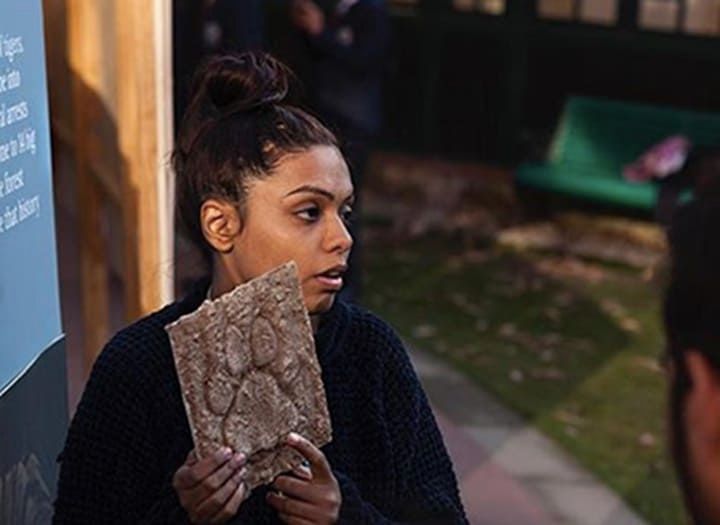#IfTreesCouldTalk is a blog series that aims to highlight one aspect of environmental impact, wildlife conservation and other issues that need to be spoken about from the natural world and our impact on it. The idea was simple. We just believe that if Mother Nature had a voice, there would be a lot she would have to say about the state of the world today and what we can do to help. This is just our effort to give her a voice.
I find that it’s the people who work at the grassroot level, who I find to be the real heroes. They lay the foundation of something bigger and better and aren’t afraid to get their hands dirty. While the topic of deforestation and poaching of animals are being spoken about more and more (as they should be), little do we pay attention to the people who are risking their lives to protect this wildlife world we call ours. They are the real deal and journalist and Pulitzer Traveling Fellow ’16, Sonali Prasad wanted to highlight that by specifically focusing on the trials and tribulations of India’s forest keepers. The Ranger Ranger project was a collaborative effort with Mukha Collective to bring this topic to everyone’s attention and start a conversation. We got in touch with her to understand the issue in detail and how we can change our attitude towards it:
Q. Two years ago, Ranger Ranger was started. What was the reason behind starting this project?
India is notorious for the highest rate of ranger mortality in the world, as per reports by the International Ranger Federation. Year after year, the non-profit’s call of honour is dotted mostly with the khaki of India’s fallen, some engulfed in raging wildfires, others at the gunpoint of merciless poachers. ‘Ranger Ranger‘ was seeded in a determination to break these numbers down and put a face to the people protecting India’s green corridors. In search of their cross-generational perspectives of what it means to live in and serve an ailing planet, I started documenting their lives through the labyrinth of India’s parks and protected areas in August 2017. Through their stories, I wanted to understand a future that takes more than a passive perspective of the changing earth into consideration. I was driven to excavate the lives of these ‘guardians’, beyond just a blurb or a news headline that clumsily scrapes at the topsoil, highlighting their injuries, fatalities or inadequacies. In partnership with creative platform Mukha, we strived at developing a strong and lingering visual identity for each story.
Q. After all your experiences on the field collecting these stories, what are the things you think the Indian public and the world at large needs to know about the conservation, wildlife and the environment?
These men and women are also vessels for stories complex and interwoven, away from the “man as hero” syndrome, mired in doubt, fear, poverty, customs, identity, religion and above all, a warming planet. There are no linear perspectives. These forest folks have flaws – ill-equipped and loosely trained, lured by temptation, their shortcuts and motivations stemming purely from the inducements of a government job or less even, daily wages. But what they lend to the conservation story is far from top-down archetypal sermons or the luxury of intellectuals, them being both the ungrateful sons and saviours, participants and witnesses to horrifying assaults on earth’s living creatures such as deforestation, sand mining, extinction, and poaching. They are containers for contemporary, multi-faceted stories of co-existence. The curtains have to fall on times when conservation and conversation were in a black hole, away from other conceptions. This is about people as complex as their ecosystems, living with other species in symbiosis, competition, stress, and struggle. They will tell you that nature is wild, nature is ancient and cannot be conquered, and nature protects if protected, not owned. Their lives reflect the truth that national parks are amoebic with fluid boundaries, those surviving wildlands are not enchanted art museums or garden islands that need to be preened for our delectation. There are tribes within parks, tuskers terrifying those tribes and trains trampling those tuskers. They are wild parts of the very world we live in: chaotic, complex, stabilizing our ruckus.
The rangers, a broad term I use for forest keepers, also challenge the narrative that it is too late, that we can only bear the brunt of emperors that were never challenged in the past. We should live knowing that change can be made as long as we are not oblivious to karma – that as long as we indulge in violence by how we live, that is, cut more trees, drive more swanky cars, drink with straws, justify forty pairs of shoes and procreate recklessly, there cannot be no repercussions.
Q. As you’ve mentioned, ranger posts were typically held by men, but that is slowly changing in many parts of India. What in your opinion is the role of women in conservation? And what are their stories?
The forest floor, in many parts of India, has long since been guarded by strong women in indigenous settings. Take, for example, the women protecting swathes of sal forests from the timber mafia in Jharkhand or the Bishnoi tribe in Rajasthan, who take in orphaned animals and raise them like their own children. However, only recently, has our focus turned towards women in uniform at different national parks. The job, per se, is considered physically arduous and not too conducive for female staff since it involves miles of trekking every day in deep jungles or across tricky terrains, as well as living for most of the year in remote sections of the wilderness. But women are stepping up to the task. There are women guards patrolling the arid expanse of Desert National Park, and then there are women who protect the Blyth’s Tragopan in the verdure hillslopes of Nagaland. Their participation in conservation is required as much as the men’s, for there is no reason for them to be excluded. Granted, they are much more effective when it comes to issues such as conflict resolution with villagers living in the fringes or within park boundaries, but at the end of the day, it is a simple story of equal opportunity. If a woman is keen and capable of serving in the wilderness, and by doing that can support her family with her livelihood, then I don’t see a reason why they can’t be remarkable rangers or forest guards. All we need to do is develop support systems around them so that they are able to work effectively.
What according to you is the most pressing issue in terms of conservation and the environment and what can the general public do to affect change?
The most pressing issue when it comes to conservation, and wildlife conservation, in particular, is culpability. We are self-proclaimed rulers who have left scars on the earth in a blip of geological time. We have lost 60 per cent of our wildlife within a span of 50 years. We have developed an inward way of living, where nature and the non-human struggle garotted on the thresholds, but in reality, we should be living circumferenced around the needs of this planet. The moral sense of “saving the earth” is slightly misplaced because we only started caring when the threats became existential. Despite all our pretence, we always have been and will remain tethered to this biological world. So we must strive to suture the wounds we have inflicted on it. But more importantly, we must not do more harm to the planet.
To affect change, there needs to be a conversation. And considering that the mantle has been assumed by schoolchildren around the world to jostle action out of world leaders, I say that we start by educating them about our wildlands. When I was exhibiting this series in Mussoorie last year, most of the high school students who visited confessed to me that they had never witnessed a tiger in the wild, or less even, visited a national park. Their memories are made up of zoos and phone screens. That needs to change. To protect something, you must love it, and to love it, you must strive to know it. We must educate our children about the earth’s bounty across terrains, from the alpine fauna to fascinating marine life, deep jungles, cavernous caves and thriving deserts. And we must do that by taking them out into the wild.
Can you share one story that has stuck with you from all your time on the field?
It is hard to single out one moment but what remains fresh in my memory is the midnight foot patrol in Sariska Tiger Reserve. I flinched at every movement; a city girl so scared of what might slither off of tree branches or jump out of bushes. In the silence of the jungle, every little ruffle, every pinch of sound is magnified. We were will within core tiger territory and I was so petrified and slightly hallucinating, that I must have clawed flesh out of the arms of the biologist accompanying me. But after an hour or so, when we reached a hilltop where there stood a small temple, we rested our eyes on the forest in a declivity, washed in quicksilver and midwived by the moon. The sight put me at ease. In the muteness of the forest, I think I shed my inhibitions in Sariska. For once, I did not feel like an interloper parachuting in for trivial recreation or selfish needs. Moving forward, I was slightly more at peace while reporting from the wilderness in different pockets across the country.
Starting a conversation is what Sonali has done and it’s up to us to keep it going. #IfTreesCouldTalk they would be asking us to do the same.

